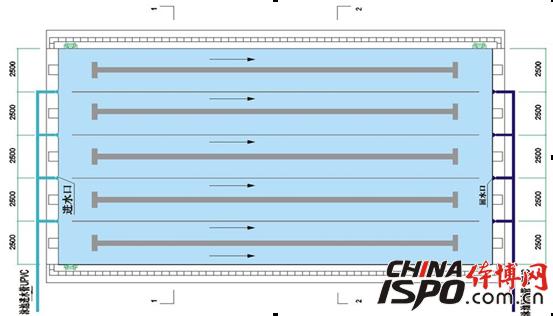There are two kinds of circulation modes that are most commonly used in swimming pools. One is a forward flow type, and the other is a reverse flow type. Because the two methods have different technical characteristics, in the actual project, the right choice must be made in conjunction with the use of the swimming pool. Don't use hard-packs. Forward flow inlet and outlet layout Downstream adopts the circulation mode of the pool walls on both sides of the swimming pool and the backwater at the deep end of the pool. The specific approach is to set the intake in the middle of the pool wall just below each swim lane line and set it at the deepest end of the pool. For several return ports, the number of intake ports is two times the number of swim lane lines, and the number of return ports is equal to the number of swim lane lines. Coupling is actually a method of simulating the movement of rivers in nature, and the treated water promotes the use of used water (ie, new water pushing old water) into the water treatment equipment, thereby avoiding the mixing of fresh water and old water. Advantages of using the downstream type: 1. The pipeline layout is simple, there is no need to set up redundant equipment such as balancing tanks, management and maintenance is difficult, investment costs are saved; 2. Without additional increase of circulating water, the efficiency of the water treatment system is high and the operating cost is saved; 3. The spillway overflowing water is not reused, and the floating surface of the pool water can be discharged from the pool through the pool bank overflow ditch, and the secondary pollution source is fundamentally eliminated. The main disadvantage of adopting the co-current type is that the overall water quality (water temperature, residual chlorine, and turbidity) of the pool is not as good as that of the counter-flow type due to the small number of inlet and outlet ports; the counter-flow type uses the bottom of the pool to inflow water, and the pool side overflows the water back to the circulation. In the method, the specific method is to set a water outlet every 3 meters on the projection line of each lane line at the bottom of the pool. At the same time, overflow ditches are installed on both sides of the swimming pool. It is actually to adopt the method of water distribution on the pool, that is, from the pool. The bottom inlet water is advanced to the water surface and finally returned to the water treatment room via the poolside overflow tank. Advantages of using counterflow: 1. The overall water quality of the pool (water temperature, residual chlorine, turbidity) is more uniform than the downstream flow; 2. Floats on the surface of the pool can be collected back to the water treatment system through the poolside overflow trough. The disadvantage of using counter-current type: 1. The layout of pipelines is very complicated. It is necessary to set up supporting equipment such as balanced water tanks. The workload of management and maintenance is large, and the investment cost is much larger than that of the forward flow type. 2. The poolside water is returned to the water treatment equipment room (short flow) via the poolside overflow tank when not in use, and the water in the pool center must go through several cycles before returning to the water treatment equipment room. The number of swimmers soars. When the amount of pollution in the pool water increases, the efficiency of water treatment is much lower than that of the downstream type. 3. Swimmers often use an overflow trough as a gutter; cleaning work is very difficult and the secondary pollution to pool water is very serious; Based on the advantages and disadvantages of the integrated downstream and countercurrent types, it can be concluded that the number of star-rated hotels, high-grade clubs, and Olympic competition venues with a small number of users and high grades are low due Water quality requirements are higher, so counter-current circulation should be adopted; swimming pools with large numbers of swimmers and open to the public, due to the large number of users, the pool water contains a large amount of pollutants, and the goal of the water treatment system must be within one cycle. Rapidly reduce the overall amount of pollution in the swimming pool, so it is advisable to use a downstream circulation.
Contact down force is one of the most important factors in achieving a properly crimped pMDI canister. This precision device measures the contact down force in deka Newtons (daN) applied to the valve during the crimping operation.
· MDI direct placement transducer
· 0 to 200 daN Digital Readout
· RS232 Computer Interface
Gauge Equipments,Down Force Equipments,Digital Push Pull Force Test Equipment Force Gauge,Down Force Gauge Equipments Anomatic(suzhou)metal packaging co,ltd , https://www.anomaticpharma.com
The advantages and disadvantages of common circulation methods in swimming pool design
Down Force Gage
Prev Article
Waste phone card making storage box